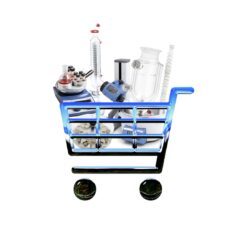It seems like the whole world goes pancake mad once a year (or more often if you’re my daughter…) but we’ve taken a look at the science of fluffy pancakes from the USA this year.
These are an altogether different creature from the very thin English or French pancakes or crepes and are typically bubbly and thick, served stacked up high with maple syrup and crispy bacon or blueberries if the world wide web is to be believed!
So I wondered what’s different about these pancakes? And why do pancake recipes always tell you not to overmix the batter? The answers to these questions lie in a protein called gluten.
Pancake batter is composed of two crucial parts: dry ingredients (usually flour, sugar, baking powder, baking soda and salt) and wet ingredients (usually milk, eggs and butter). Flour contains starch and protein. A starch is like a long chain of simple sugars. An example of a simple sugar is glucose, which is what plants produce to feed themselves in a chemical process called photosynthesis. A protein is a long, chainlike molecule made up of smaller molecules called amino acids. Flour contains a protein called glutenin (or gluten), which is crucial for the formation and structure of pancakes and baked goods. Gluten also provides the “chewy” texture in pancakes and breads.
When the flour is dry, the gluten molecules are nearly immobile, which means that they do not move much. They also do not bond (or “link”) to one another. When the flour is moistened with water (or with milk and eggs, which are composed mainly of water), the gluten molecules become active. Wet gluten molecules are elastic and springlike (which means that they can change shape under pressure) and plastic (meaning they can maintain their shapes after being stretched and moved around). When flour is mixed with water, gluten proteins loosen from one another, stretch out and begin to rearrange. Further mixing allows the end of a gluten protein to bond with the end of another gluten protein. As the gluten proteins come in contact with one another, they continue to bond. With additional mixing, the proteins create a tighter and tighter weblike network of proteins that are able to trap air bubbles. When chemical leaveners, such as baking powder, create bubbles in a cooked pancake, the gluten network traps these bubbles and allows a pancake to rise and stay fluffy yet still keep its shape.
American Pancake Recipe from CooksIllustrated.com
Recipe makes about 12 small pancakes, enough for four to six people usually, or possibly one to two people in my house…
Materials
• One tablespoon (tbsp) lemon juice from one lemon
• Two cups of milk
• Two cups all purpose flour
• Two tbsp granulated sugar
• Two teaspoons (tsp) baking powder
• One-half tsp baking soda
• One-half tsp salt
• One large egg
• Three tbsp butter, melted and cooled slightly
• Two tsp vegetable or canola oil
• Large mixing bowl
• Rubber spatula
• Griddle or 12-inch nonstick skillet
• Wire whisk
• Measuring spoons
• Dry – ingredient measuring cups
• Liquid – ingredient measuring Cups
• Stove top
Preparation
• Turn on the stove – top burner when you are ready to cook the pancakes.
• Make sure to wash your hands thoroughly both before and after the experiment.
Procedure
• Whisk lemon juice and milk in a medium bowl or large measuring cup; set aside to thicken while preparing other ingredients.
• Whisk together flour, sugar, baking powder, baking soda and salt.
• Whisk egg and melted butter into milk until combined. Make a well in the center of the dry ingredients in the bowl. Pour in milk mixture and whisk very gently until everything is mixed but it’s not completely smooth.
• Heat a 12-inch nonstick skillet over medium heat for three to five minutes.
• Add one teaspoon of oil to the skillet or griddle and coat the bottom evenly. Use a measuring cup to scoop batter. Place one-quarter cup of batter onto two to four spots on the skillet (each pancake will contain one-quarter cup of batter). Cook the pancakes until large bubbles begin to appear. Using a thin, wide spatula, flip pancakes and cook until golden brown on second side. Put the two pancakes on a plate.
If we had mixed the batter until it was completely smooth the gluten would have organized itself into more tightly wound, side-by-side bonds in a very strong weblike network. This allows for more of those gridlike side-by-side gluten bonds, which make the cooked pancake turn out flatter.
Cleanup
Eat any remaining pancakes—and share with helpers, family and friends. (Leftovers?? In what world? lol!)
(Some content shared from the Scientific American site)
Conclusion
So from this we understand that how you stir something is really important. We haven’t gone quite as far as using our ReactoMate baffled kits to make these but I think the mixture would end up being too efficiently stirred and we wouldn’t have those occasional lumps of flour that make all the difference. Maybe they’d be ok for English pancakes? Have a look at our videos demonstrating the difference particular stirrers or baffles can make though – it’s quite an eye opener!





